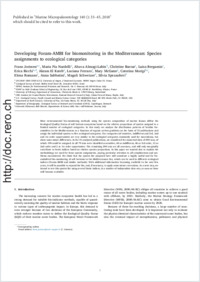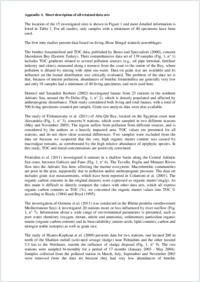Developing Foram-AMBI for biomonitoring in the Mediterranean: Species assignments to ecological categories
- Jorissen, Frans LPG-BIAF UMR CNRS 6112, University of Angers, France
- Nardelli, Maria Pia LPG-BIAF UMR CNRS 6112, University of Angers, France
- Almogi-Labin, Ahuva Geological Survey of Israel, Jerusalem, Israel
- Barras, Christine LPG-BIAF UMR CNRS 6112, University of Angers, France
- Bergamin, Luisa ISPRA, Institute for Environmental Protection and Research, Rome, Italy
- Bicchia, Erica ESAIP La Salle Graduate School of Engineering, St. Barthélemy d'Anjou, France
- El Kateb, Akram University of Fribourg, Department of Geosciences, Fribourg, Switzerland
- Ferraro, Luciana CNR, Institute for Coastal Marine Environment, National Research Council of Italy, Calata Porta di Massa, Naples, Italy
- Gann, Mary Mc U.S. Geological Survey, Pacific Coastal and Marine Science Center, Menlo Park, CA, USA
- Morigi, Caterina Department of Earth Sciences, University of Pisa, Italy - Department of Stratigraphy, Geological Survey of Denmark and Greenland (GEUS), Copenhagen, Denmark
- Romano, Elena ISPRA, Institute for Environmental Protection and Research, Rome, Italy
- Sabbatini, Anna Università Politecnica delle Marche, Dipartimento di Scienze della Vita e dell'Ambiente, Ancona, Italy
- Schweizer, Magali LPG-BIAF UMR CNRS 6112, University of Angers, France
- Spezzaferri, Silvia University of Fribourg, Department of Geosciences, Fribourg, Switzerland
-
01.04.2018
Published in:
- Marine Micropaleontology. - 2018, vol. 140, p. 33–45
English
Most environmental bio-monitoring methods using the species composition of marine faunas define the Ecological Quality Status of soft bottom ecosystems based on the relative proportions of species assigned to a limited number of ecological categories. In this study we analyse the distribution patterns of benthic foraminifera in the Mediterranean as a function of organic carbon gradients on the basis of 15 publications and assign the individual species to five ecological categories. Our categories (of sensitive, indifferent and 3rd, 2nd and 1st order opportunists) are very similar to the ecological categories commonly used for macrofauna, but show some minor differences. In the 15 analysed publications, we considered the numerical data of 493 taxa, of which 199 could be assigned. In all 79 taxa were classified as sensitive, 60 as indifferent, 46 as 3rd order, 12 as 2nd order and 2 as 1st order opportunists. The remaining 294 taxa are all accessory, and will only marginally contribute to biotic indices based on relative species proportions. In this paper we wanted also to explain the methodology we used for these species assignments, paying particular attention to all complications and problems encountered. We think that the species list proposed here will constitute a highly useful tool for foraminiferal bio-monitoring of soft bottoms in the Mediterranean Sea, which can be used in different ecological indices (Foram-AMBI and similar methods). With additional information becoming available in the next few years, it will be possible to expand the list, and, if necessary, to apply some minor corrections. As a next step, we intend to test this species list using several biotic indices, in a number of independent data sets, as soon as these will become available.
- Faculty
- Faculté des sciences et de médecine
- Department
- Département de Géosciences
- Language
-
- English
- Classification
- Biological sciences
- License
-
License undefined
- Identifiers
-
- RERO DOC 309013
- DOI 10.1016/j.marmicro.2017.12.006
- Persistent URL
- https://folia.unifr.ch/unifr/documents/306595
Other files
Statistics
Document views: 109
File downloads:
- pdf: 260
- Supplementary material: 217

